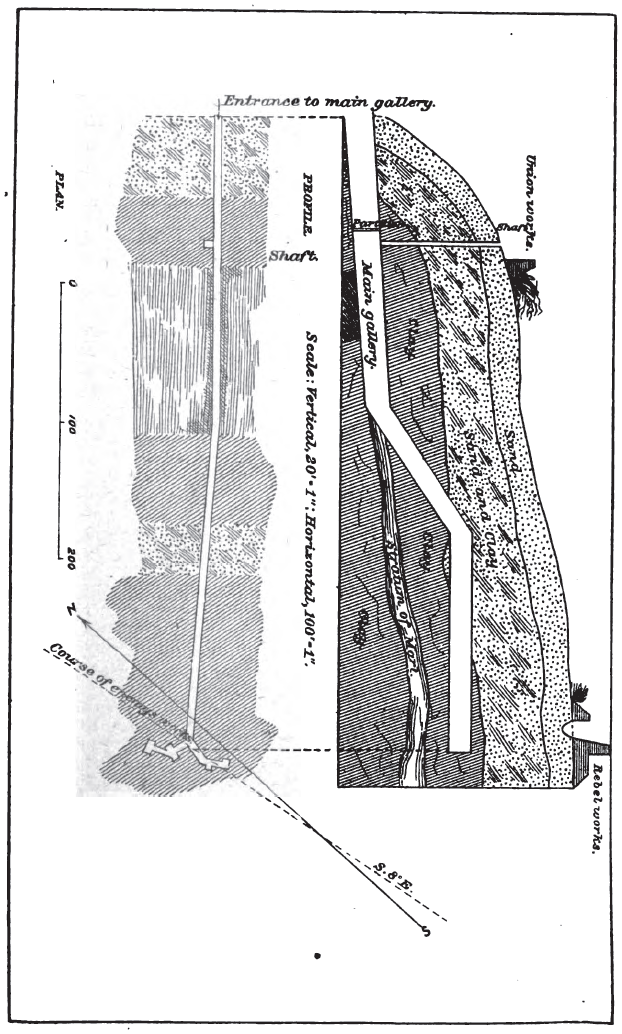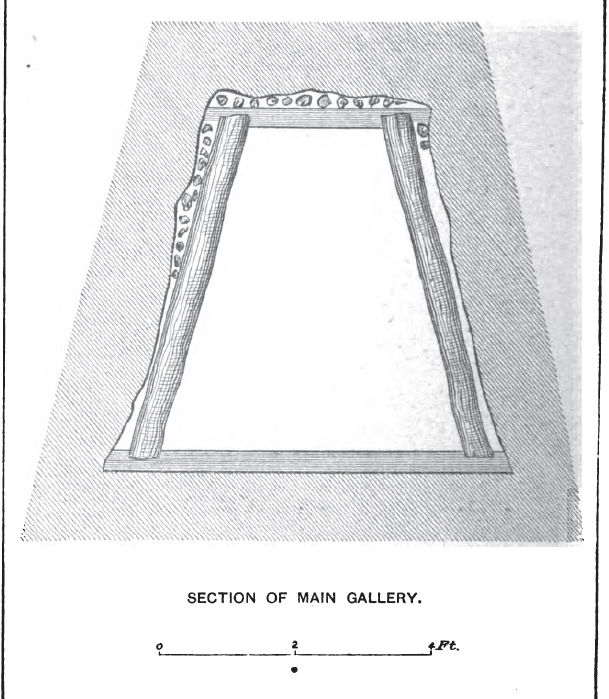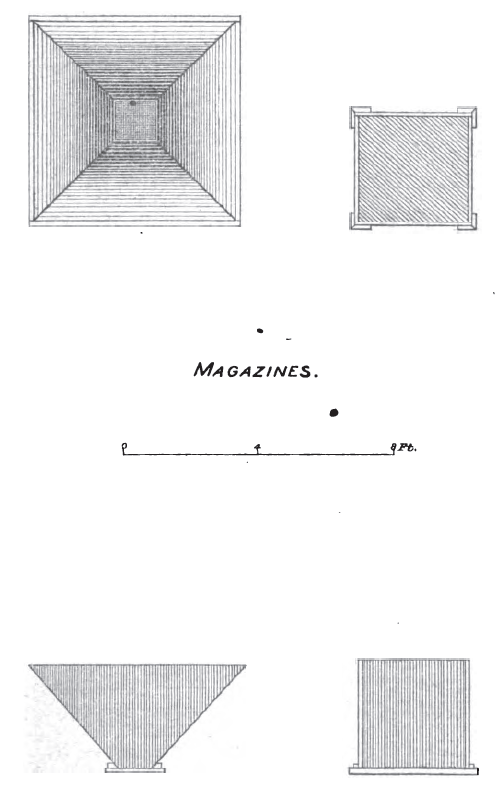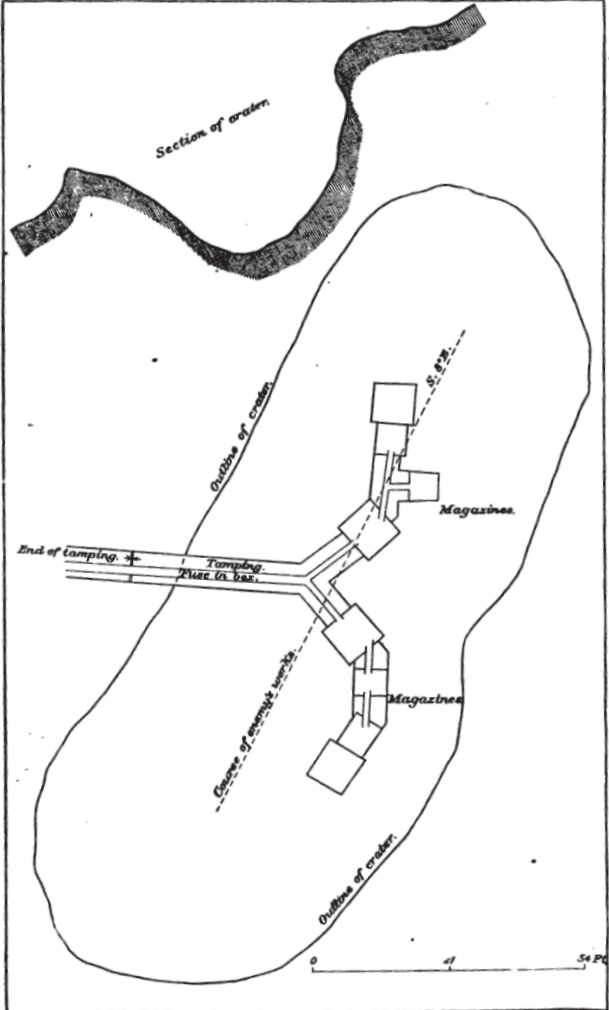No. 190. Report of Lieutenant Colonel Henry Pleasants, Forty-eighth Pennsylvania Infantry, of operations June 25-July 30.1
HDQRS. FORTY-EIGHTH PENNSYLVANIA VETERAN VOLS.,
Near Petersburg, Va., August 2, 1864.
COLONEL: I have the honor to submit the following report, relating to the mine I excavated in front of the Second Division of the Ninth Corps:
It was commenced at 12 m. the 25th of June, 1864, without tools, lumber, or any of the material requisite for such work. The mining
picks were made out of those used by our pioneers; plank I obtained, at first, by tearing down a rebel bridge, and afterward by sending to a saw-mill, five or six miles distant. The material excavated was carried out in hand barrows made out of cracker-boxes. The work progressed rapidly until the 2nd of July, when it reached an extremely wet ground; the timbers gave way and the gallery nearly closed, the roof and floor of the mine nearly meeting. Retimbered it and started again. From this point had to excavate a stratum of marl, whose consistency was like putty, and which caused our progress to be necessarily slow. To avoid this I started an incline plane, and in about 100 feet rose thirteen and a half feet perpendicularly.
On the 17th of July the main gallery was completed, being 510.8 feet in length. The enemy having obtained some knowledge of the mine, and having commenced searching for it, I was ordered to stop mining, which was, however, resumed on the 18th of July by starting the left lateral gallery.
At 6 p.m. July 18 commenced the right lateral gallery; but as the enemy could be heard very plainly working in the fort over us I caused this gallery to be excavated a little beyond and in rear of their work, and gave to it a curved line of direction. The left gallery, being thirty seven feet long, was stopped at midnight on Friday, July 22; the right gallery, being thirty-eight feet long, was stooped at 6 p.m. July 23. The mine could have been charged and exploded at this time. I employed the men, from that time, in draining, timbering, and placing in position eight magazines, four in each lateral gallery.
Having received the order to charge the mine on the 27th of July, I commenced putting in the powder at 4 p.m., and finished at 10 p.m.
The tamping was begun at 10 p.m. July 27, and completed at 6 p.m. July 28. Thirty-four feet of main gallery was tamped, and ten feet of the entrance of each of the side galleries; but the space between the magazines was left untamped.
I received orders from corps headquarters, on the 29th of July, to fire the mine at 3.30 a.m. July 30. I lighted the fuse at 3.15 a.m., and having waited till 4.15 a.m. an officer and sergeant of my regiment volunteered to go in and examine into the cause of the delay, and found that the fire had stopped where the fuses were spliced. They relighted it, and at sixteen minutes of 5 the powder exploded.
The charge consisted of 320 kegs of powder, each containing about twenty-five pounds. It was placed in eight magazines connected with each other by troughs half filled with powder. These troughs from the lateral galleries met at the inner end of the main one, and from this point I had three lines of fuses for a distance of ninety-eight feet. Not having fuses as long as required two pieces had to be spliced together to make the required length of each of the lines.
The mine was ventilated at first by having the fresh air go in along the main gallery as far as it was excavated, and to return charged with the gases generated by the breathing and exhalation of the workmen, by the burning of the candles, and by those liberated from the ground, along and in a square tube made of boards, and whose area was sixty inches. This tube led to a perpendicular shaft twenty-two feet high, out of which this vitiated air escaped. At the bottom of this shaft was placed a grating, in which a large fire was kept burning continually, which, by heating the air, rarefied it, and increased its current. Afterward I caused the fresh air to be let in the above-mentioned wooden tube to the end of the work, and the vitiated air to return by the gallery
and out of the shaft, placing a partition with a door in the main gallery a little out of the shaft, to prevent its exit by the entrance of the mine. The latter plan was more advantageous, because the gases had to travel a less distance in the mine than before.
As the excavation in the mine progressed, the number of men required to carry out the material increased, until at last it took nearly every enlisted man in my regiment, which consisted of nearly 400 effective men. The whole amount of material excavated was 18,000 cubic feet.
The great difficulty to surmount was to ascertain the exact distance from the entrance of the mine to the enemy’s works, and the course of these works. This was accomplished by making five separate triangulations, which differed but slightly in their result. These triangulations were made in our most advanced line, and within 133 yards of the enemy’s line of sharpshooters.
The size of the crater formed by the explosion was at least 200 feet long, 50 feet wide, and 25 feed deep.
I stood on top of our breast-works and witnessed the effect of the explosion on the enemy. It so completely paralyzed them that the breach was practically 400 or 500 yards in breadth. The rebels in the forts, both on the right and left of the explosion, left their works, and for over an hour not a shot was fired by their artillery. There was no fire from infantry from the front for at least half an hour; none from the left for twenty minutes, and but few shots from the right. The accompanying drawings which I have made, and forward with this report, will explain whatever else has been omitted here.*
I have the honor to be, colonel, very respectfully, your obedient servant,
HENRY PLEASANTS,
Lieutenant-Colonel.
ADDENDA.
GENERAL ORDERS,
HDQRS. ARMY OF THE POTOMAC,
No. 32. August 3, 1864.
The commanding general takes great pleasure in acknowledging the valuable services rendered by Lieutenant Colonel Henry Pleasants, Forty-eighth Regiment Pennsylvania Veteran Volunteers, and the officers and men of his command, in the excavation of the mine which was successfully exploded on the morning of the 30th ultimo under one of the enemy’s batteries in front of the Second Division of the Ninth Army Corps.
The skill displayed in the laying out of and construction of the mine reflects great credit upon Lieutenant-Colonel Pleasants, the officer in charge, and the willing endurance by the officers and men of the regiment of the extraordinary labor and fatigue involved in the prosecution of the work to completion is worthy of the highest praise.
By command of Major-General Meade:
S. WILLIAMS,
Assistant Adjutant-General.
—————
—————
—
—
—
—
—
Source:






